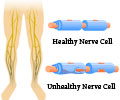Peripheral neuropathic pain caused by the cancer drug bortezomib can now be treated with a multiple sclerosis drug.
- A common multiple sclerosis drug, fingolimod could reduce the side effects of a chemotherapeutic used in myeloma patients, according to a study.
- Chemotherapy-induced peripheral neuropathy or CIPN is a major side effect caused by the cancer drug bortezomib.
- Fingolimod reverses bortezomib’s neuropathic pain by acting on sphingolipid receptors.
"This growing problem is a major unmet clinical need because the increased efficacy of cancer therapy has resulted in nearly 14 million cancer survivors in the United States, many suffering from the long-term side effects of CIPN," says Daniela Salvemini, Professor of Pharmacology and Physiology at the Saint Louis University School of Medicine.
Bortezomib-induced Neuropathy
Bortezomib is a drug used to treat multiple myeloma and mantle cell non-Hodgkin’s lymphoma. The drug causes chronic, distal, and symmetrical sensory peripheral neuropathy, that is often accompanied with CIPN in over 40% of cancer patients, lasting even for years after treatment. CIPN interferes with effective cancer treatment making patients terminate chemotherapy and also affects the quality of life (QOL). The reason why Bortezomib causes CIPN has been unknown.Discovering the Mechanism of Bortezomib causing CIPN
Sphingolipids are a class of molecules that have previously been linked to neuropathic pain. In the current study, Salvemini and colleagues found that bortezomib treated rats accelerated the production of sphingolipids and causing accumulation of two sphingolipid metabolites (sphingosine 1-phosphate and dihydrosphingosine 1-phosphate) in their spinal cords showing signs of neuropathic pain. However, if the production of the sphingolipids were blocked, the rats did not develop CIPN even when they received bortezomib.The researchers discovered that the two metabolites cause CIPN by activating a cell surface sphingolipid metabolite receptor protein called S1PR1 on the surface of specialized central nervous system support cells called astrocytes. Spinal cords of rats treated with bortezomib increased numbers of astrocytes that cause neuropathic pain.
Another method to prevent the rats from developing CIPN in response to bortezomib is to use drugs that inhibit S1PR1.
Fingolimod an orally administered drug approved to treat multiple sclerosis is one such inhibitor of S1PR1. Fingolimod does not interfere with the ability of bortezomib to kill myeloma cells and has the added advantage of working independently to inhibit tumor growth and thus enhance the effects of bortezomib.
References:
- Katherine Stockstill, Timothy M. Doyle, Xisheng Yan, Zhoumou Chen, Kali Janes, Joshua W.Little, Kathryn Braden, Filomena Lauro, Luigino Antonio Giancotti, Caron Mitsue Harada, RuchiYadav, Wen Hua Xiao, Jack M. Lionberger, William L. Neumann, Gary J. Bennett, Han-RongWeng, Sarah Spiegel, Daniela Salvemini ”Dysregulation of sphingolipid metabolism contributes to bortezomib-induced neuropathic pain” Journal of Experimental Medicine Apr (2018), jem.20170584; DOI: 10.1084/jem.20170584













